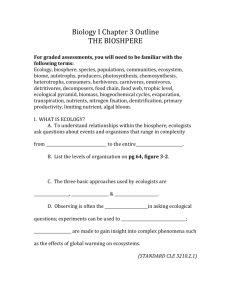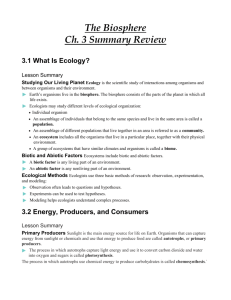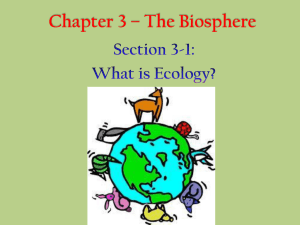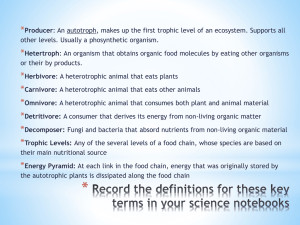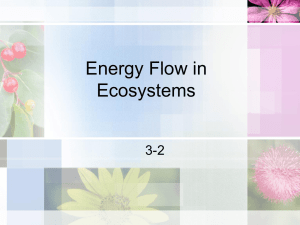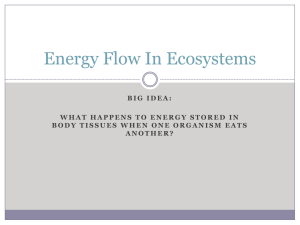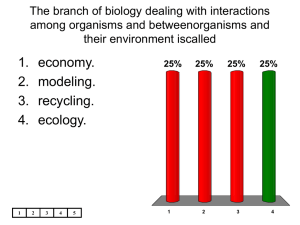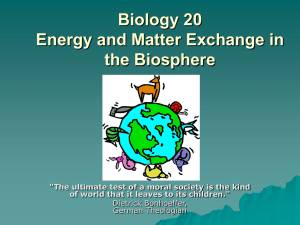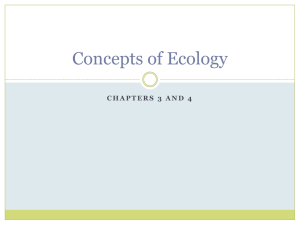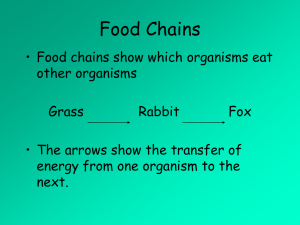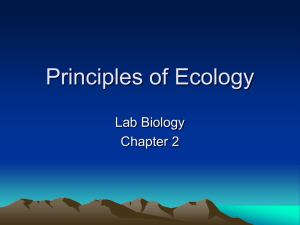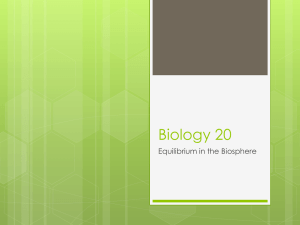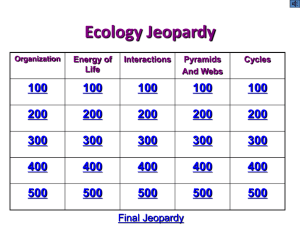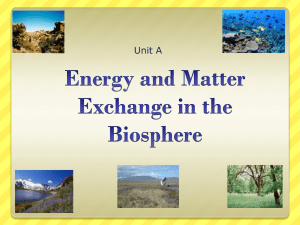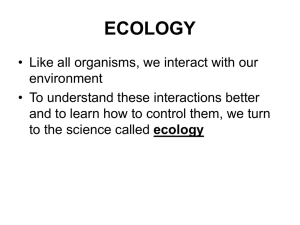biosphere - Akron Central Schools
advertisement
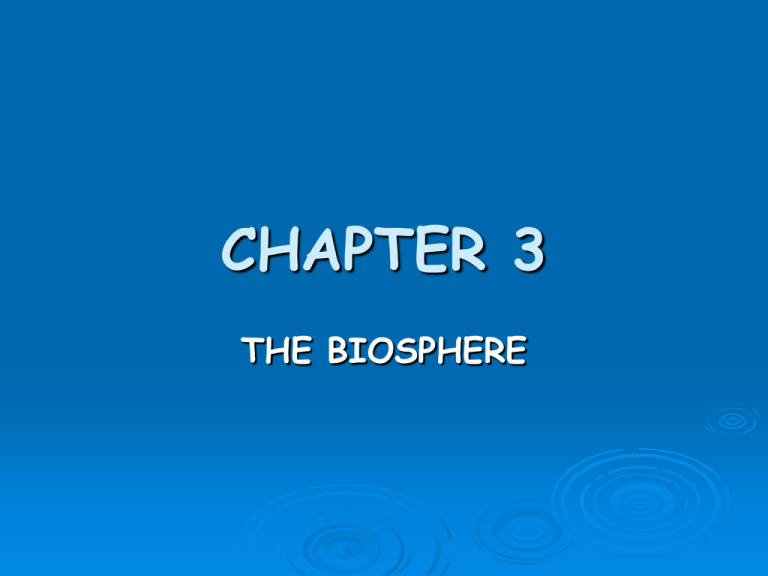
CHAPTER 3 THE BIOSPHERE 3–1 What Is Ecology? Ecology is the scientific study of interactions among organisms and between organisms and their environment. Earth’s organisms live in the biosphere. The biosphere consists of the parts of the planet in which all life exists. It includes land, water, and air, or atmosphere. Ecology includes the study of all the different levels of life, ranging from the individual organism to the biosphere. Above the level of the individual organism is the species. A species is a group of organisms so similar to one another that they can breed together and produce fertile offspring. A group of individuals that belong to the same species and live in the same area is called a population. A collection of different populations that live together in an area is referred to as a community. An ecosystem includes all the organisms that live in a particular place, together with their physical environment. A group of ecosystems that have the same climate and similar dominant communities is called a biome. Ecologists use three basic methods of research: observing, experimenting, and modeling. Observing often leads to questions and hypotheses. Experimenting can be used to test hypotheses. Experimenting may be done in a laboratory or in the natural world. Modeling helps ecologists understand complex processes. 3–2 Energy Flow All organisms need to obtain energy from their environment to power life processes. Sunlight is the main energy source for life on Earth. Some organisms rely on the energy stored in inorganic chemical compounds. Organisms that can capture energy from sunlight or chemicals and use that energy to produce food are called autotrophs. Autotrophs are also known as producers. Only plants, some algae, and certain bacteria are producers. On land, plants are the main autotrophs. The process in which autotrophs use light energy to make food is called photosynthesis. PHOTOSYNTHESIS 6CO2 + 6H2O In photosynthesis, light provides the energy needed to turn carbon dioxide and water into oxygen and carbohydrates. light C6H12O6 + 6O2 The process in which autotrophs use chemical energy to produce carbohydrates is called chemosynthesis. Chemosynthesis is performed by only certain types of bacteria. Organisms that rely on other organisms for their energy and food are called heterotrophs. Heterotrophs are also referred to as consumers. There are many different types of heterotrophs. Herbivores, such as cows, obtain energy by eating only plants. Carnivores, such as snakes, eat only animals. Omnivores, such as humans, eat both plants and animals. Detritivores, such as earthworms, feed on plant and animal remains and other dead matter. Decomposers, such as fungi, break down organic matter. Energy flows through an ecosystem in one direction. It flows from the sun, or from inorganic compounds, first to autotrophs and then to heterotrophs. A food chain is a series of steps in which organisms transfer energy by eating and being eaten. A food web links together all the food chains in an ecosystem. Each step in a food chain or food web is called a trophic level. Producers make up the first trophic level. Consumers make up higher trophic levels. Each consumer depends on the trophic level below it for energy. An ecological pyramid is a diagram that shows the relative amounts of energy or matter contained within each trophic level in a food chain or food web. Types of ecological pyramids are energy pyramids, biomass pyramids, and pyramids of numbers. Energy pyramids show how much energy is available within each trophic level. Only about 10 percent of the energy available within one trophic level is transferred to organisms at the next trophic level. Biomass pyramids show the biomass, or total amount of living tissue, within each trophic level. A pyramid of numbers shows the relative number of individual organisms at each trophic level. 3–3 Cycles of Matter Matter, unlike energy, is recycled within and between ecosystems. Matter is passed from one organism to another and from one part of the biosphere to another through biogeochemical cycles. These cycles connect biological, geological, and chemical processes. Matter can cycle through the biosphere because biological systems do not use up matter, they only change it. All living things require water to survive. Water cycles between the ocean, atmosphere, and land. Several different processes are involved in the water cycle, including evaporation and transpiration. Evaporation is the process in which water changes from a liquid to a gas. Transpiration is the process in which water evaporates from the leaves of plants. All the chemical substances that an organism needs to survive are called nutrients. Like water, nutrients cycle within and between ecosystems. The three most important nutrient cycles are the carbon, nitrogen, and phosphorus cycles. Carbon is a key ingredient of living tissue. Processes involved in the carbon cycle include photosynthesis and human activities such as burning. Nitrogen is needed by all organisms to build proteins. Processes involved in the nitrogen cycle include nitrogen fixation and denitrification. In nitrogen fixation, certain bacteria convert nitrogen gas into ammonia. In denitrification, other bacteria convert nitrogen compounds called nitrates back into nitrogen gas. Phosphorus is needed for molecules such as DNA and RNA. Most of the phosphorus in the biosphere is stored in rocks and ocean sediments. Stored phosphorus is gradually released into water and soil, where it is used by organisms. The primary productivity of an ecosystem is the rate at which organic matter is created by producers. One factor that controls primary productivity is the amount of available nutrients. When an ecosystem is limited by a single nutrient that is scarce or cycles very slowly, this substance is called a limiting nutrient. If an aquatic ecosystem receives a large quantity of a limiting nutrient, there may be a sudden increase in the amount of algae, called an algal bloom.
